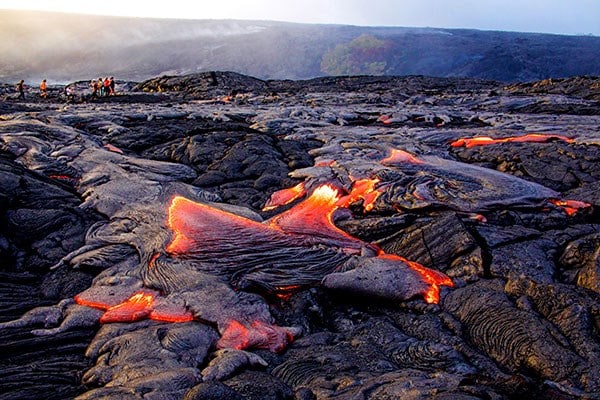
Ascending an active volcano demands a resilient spirit. The challenging landscape, extreme temperature fluctuations, hours of strenuous exertion, and the ever-present potential for a volcanic eruption, with lava cascading down the very slopes you’re ascending, can be daunting. Fortunately, the latter scenario typically poses a minimal threat, and the gratification of witnessing lava pour into the ocean or erupt into the heavens justifies the arduous journey.
Volcanoes National Park, Hawaii
Two of Hawaii’s six active volcanoes are contained within Volcanoes National Park on the Big Island. Kilauea, the star of the park, is one of the most active in the world, with nearly continuous eruption since 1983. In May 2021, the U.S. Geological Survey reported a cease in eruptions, although future ones are likely
When Kilauea’s lava flows, eruptions are typically calm, and anyone can watch the bright orange molten rock flowing into the Pacific Ocean from a coastal lava viewing area about 900 feet from the flow itself.
Erta Ale, Ethiopia
Ethiopia’s most active volcano is often described as “hell on Earth,” and not just because of the rare lava lake in its crater. The journey to Erta Ale begins with a five-hour drive through the desert, which can wind up lasting a full day in harsh wind and sand conditions. The last part of the drive goes right through a bumpy field of hardened lava. From the base of Erta Ale, it’s a three-hour hike in the dark.
Democratic Republic of the Congo
Mount Nyiragongo has the world’s largest lava lake in its crater. This stratovolcano is known for its fluid lava that flows almost like water. One of the most recent eruptions occurred in 2002, sending lava flowing into the city of Goma and killing around 170 people. The volcano also erupted in May of 2021, taking dozens of lives and homes in Goma.
Mount Etna, Italy
Mount Etna is actually comprised of several stratovolcanoes that have four distinct summit craters. It has a longer written history of eruptions than any other volcano, dating back to 425 B.C.E. Etna’s history can be seen in the centuries-old solidified lava flows that reach nearby towns and villages. It may encounter slow-moving lava flowing from the numerous fissures and vents located at low altitude.
Pacaya, Guatemala
Guatemala’s Pacaya is an active complex volcano that first erupted about 23,000 years ago and has been erupting near continuously since 1965. That it’s close to Antigua and less than 20 miles from Guatemala City makes it an especially popular people attraction. Pacaya is part of the Central American Volcanic Arc, a chain of volcanoes stretching along the Pacific Coast of Central America.